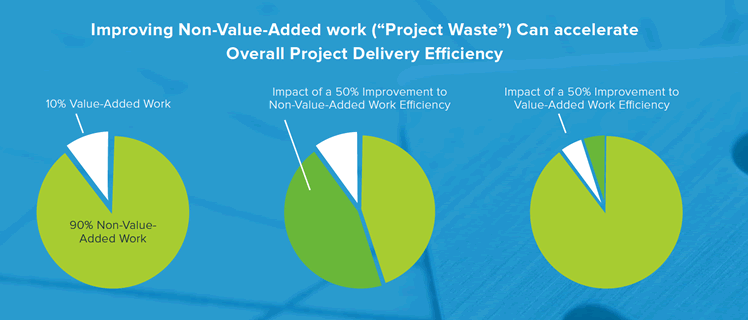Sciforma is urging its prospects and customers to focus on something called project waste. Before telling you why, first let’s define what project waste refers to.
Project waste refers generally to the time wasted performing all of the non-value-added work that is performed during the lifecycle of a project.
Specifically, it is the difference between the time it actually takes to complete non-value-added tasks and the time it could take if the process associated with those tasks were fully automated.
Here are some examples of tasks that are rife with project waste:
- Collecting, reconciling data discrepancies, and formatting data for various reports and PPM project reviews, as well as manual quality checking
- Searching for information like project templates, metrics, and financial data. Many organizations report that project managers and team members spend over a day a week just looking for information.
- Filling in timesheets is another mundane activity that takes time but delivers no direct value
- Manually, uploading transferring to data to and between spreadsheets, MS project and other systems
- Managing and coordinating project and work activity handoffs.
Why give “project waste” special attention?
Most PMOs or project delivery organizations underestimate the amount of total work can be attributed to non-value-added activities. According to research published in Lean Office Innovation, 90% of all office work of any kind is non-value added. Only 10% of work can be categorized as value add. But, that’s where all the focus is: project selection, resource management, capacity planning, project and task execution, portfolio planning, risk assessment and so on. It is critical that you optimize the process and outcomes for these value-add tasks, but that doesn’t mean you should ignore the mundane non-value-added tasks because this is the low-hanging fruit for PPM process improvement and while it’s non-intuitive this can make a dramatic improvement in your overall PPM productivity and key metrics like project cycle time.

Here’s the math. Improving productivity by say 50% for non-value-added tasks versus value-added tasks, yields a much greater impact on overall project delivery productivity. If you focus only on the 10%, the simple math tells you that you a constrained to single-digit productivity improvements.
In our next post, we will discuss what an initiative might look like to address project waste. This is also the subject of our eBook: Solution Framework for Eliminating Project Waste from Non-Value-Added Tasks.







Valerie Zeller
Valerie is Sciforma Chief Marketing Officer. Main interests: digital transformation, change management, strategy execution. Send your thoughts @valeriezeller